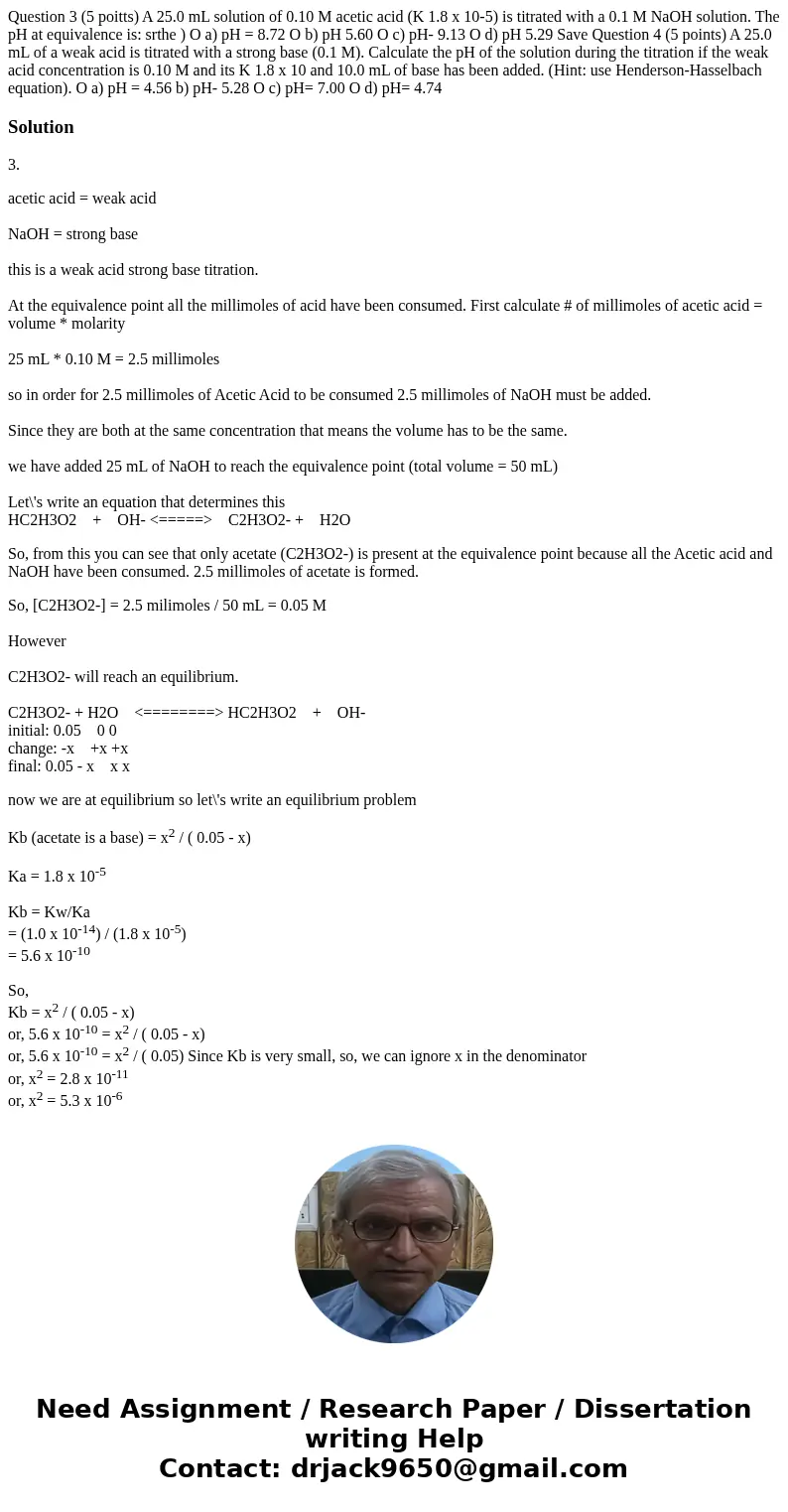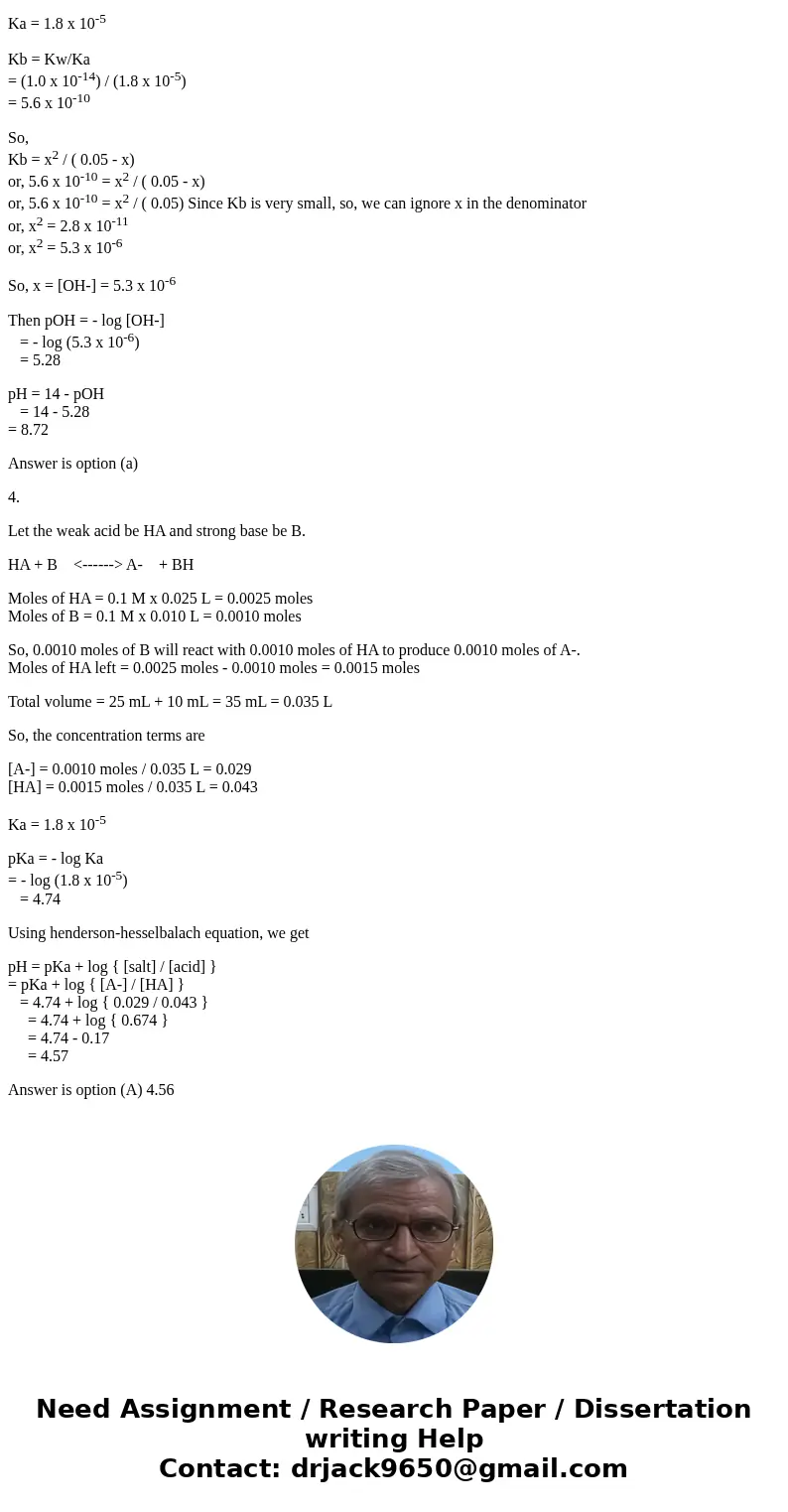Question 3 5 poitts A 250 mL solution of 010 M acetic acid K
Solution
3.
acetic acid = weak acid
NaOH = strong base
this is a weak acid strong base titration.
At the equivalence point all the millimoles of acid have been consumed. First calculate # of millimoles of acetic acid = volume * molarity
25 mL * 0.10 M = 2.5 millimoles
so in order for 2.5 millimoles of Acetic Acid to be consumed 2.5 millimoles of NaOH must be added.
Since they are both at the same concentration that means the volume has to be the same.
we have added 25 mL of NaOH to reach the equivalence point (total volume = 50 mL)
Let\'s write an equation that determines this
HC2H3O2 + OH- <=====> C2H3O2- + H2O
So, from this you can see that only acetate (C2H3O2-) is present at the equivalence point because all the Acetic acid and NaOH have been consumed. 2.5 millimoles of acetate is formed.
So, [C2H3O2-] = 2.5 milimoles / 50 mL = 0.05 M
However
C2H3O2- will reach an equilibrium.
C2H3O2- + H2O <========> HC2H3O2 + OH-
initial: 0.05 0 0
change: -x +x +x
final: 0.05 - x x x
now we are at equilibrium so let\'s write an equilibrium problem
Kb (acetate is a base) = x2 / ( 0.05 - x)
Ka = 1.8 x 10-5
Kb = Kw/Ka
= (1.0 x 10-14) / (1.8 x 10-5)
= 5.6 x 10-10
So,
Kb = x2 / ( 0.05 - x)
or, 5.6 x 10-10 = x2 / ( 0.05 - x)
or, 5.6 x 10-10 = x2 / ( 0.05) Since Kb is very small, so, we can ignore x in the denominator
or, x2 = 2.8 x 10-11
or, x2 = 5.3 x 10-6
So, x = [OH-] = 5.3 x 10-6
Then pOH = - log [OH-]
= - log (5.3 x 10-6)
= 5.28
pH = 14 - pOH
= 14 - 5.28
= 8.72
Answer is option (a)
4.
Let the weak acid be HA and strong base be B.
HA + B <------> A- + BH
Moles of HA = 0.1 M x 0.025 L = 0.0025 moles
Moles of B = 0.1 M x 0.010 L = 0.0010 moles
So, 0.0010 moles of B will react with 0.0010 moles of HA to produce 0.0010 moles of A-.
Moles of HA left = 0.0025 moles - 0.0010 moles = 0.0015 moles
Total volume = 25 mL + 10 mL = 35 mL = 0.035 L
So, the concentration terms are
[A-] = 0.0010 moles / 0.035 L = 0.029
[HA] = 0.0015 moles / 0.035 L = 0.043
Ka = 1.8 x 10-5
pKa = - log Ka
= - log (1.8 x 10-5)
= 4.74
Using henderson-hesselbalach equation, we get
pH = pKa + log { [salt] / [acid] }
= pKa + log { [A-] / [HA] }
= 4.74 + log { 0.029 / 0.043 }
= 4.74 + log { 0.674 }
= 4.74 - 0.17
= 4.57
Answer is option (A) 4.56


 Homework Sourse
Homework Sourse